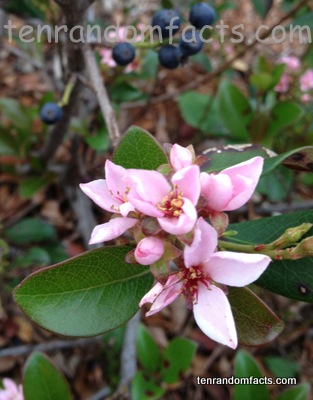Another pretty flower.
- Rhaphiolepis is a flowering genus that is from the family Rosaceae, the family of roses, and the genus is a close relative to loquats.
- Rhaphiolepis is an evergreen plant that grows as a small shrub or as big as a small tree, and are generally best grown in full sun.
- South East Asia is the native home of Rhaphiolepis, and it can be found in southern Japan, Korea and China, as well as Thailand and Vietnam.
- There are fifteen species of Rhaphiolepis, the most common, Rhaphiolepis indica is known as Indian hawthorn, despite being native to China, and is considered as a weed in some areas.
- Rhaphiolepis can grow from 60 cm to 10 metres (2 to 32.8 feet) in height, depending on the species.
- Rhaphiolepis has five petal flowers that are white to pink in colour, that usually have a sweet smell, and small berries, pomes, that range from purple, blue and black in colour.
- In humid environments, Rhaphiolepis is quite vunerable to the disease leaf spot, where dark spots, caused by a fungus, form on the plant’s leaves.
- Rhaphiolepis are commonly used as a hedging plant, and Rhaphiolepis indica makes an excellent bonsai specimen.
- The hardiest species of Rhaphiolepis, Rhaphiolepis umbellata, is known as Yeddo hawthorn, or Japanese hawthorn, and can withstand temperatures as low as -15 °C (5 °F), strong winds and salt spray, and is native to Japan and Korea.
- The fruit of some species of Rhaphiolepis can be cooked into jam, and the bark of the Japanese hawthorn, Rhaphiolepis umbellata is used to make a brown dye.





